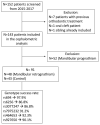Parathyroid Hormone Gene and Genes Involved in the Maintenance of Vitamin D Levels Association with Mandibular Retrognathism
- PMID: 34063310
- PMCID: PMC8147469
- DOI: 10.3390/jpm11050369
Parathyroid Hormone Gene and Genes Involved in the Maintenance of Vitamin D Levels Association with Mandibular Retrognathism
Abstract
In this study we evaluated whether single nucleotide polymorphisms (SNPs) in the genes encoding PTH, VDR, CYP24A1, and CYP27B1 were associated with mandibular retrognathism (MR). Samples from biologically-unrelated Brazilian patients receiving orthodontic treatment were included in this study. Pre-orthodontic lateral cephalograms were used to determine the phenotype. Patients with a retrognathic mandible were selected as cases and those with an orthognathic mandible were selected as controls. Genomic DNA was used for genotyping analysis of SNPs in PTH (rs694, rs6256, and rs307247), VDR (rs7975232), CYP24A1 (rs464653), and CYP27B1 (rs927650). Chi-squared or Fisher's tests were used to compare genotype and allele distribution among groups. Haplotype analysis was performed for the SNPs in PTH. The established alpha was p < 0.05. Multifactor dimensionality reduction (MDR) was used to identify SNP-SNP interactions. A total of 48 (22 males and 26 females) MR and 43 (17 males and 26 females) controls were included. The linear mandibular and the angular measurements were statistically different between MR and controls (p < 0.05). In the genotype and allele distribution analysis, the SNPs rs694, rs307247, and rs464653 were associated with MR (p < 0.05). MDR analyses predicted the best interaction model for MR was rs694-rs927650, followed by rs307247-rs464653-rs927650. Some haplotypes in the PTH gene presented statistical significance. Our results suggest that SNPs in PTH, VDR, CYP24A1, and CYP27B1 genes are associated with the presence of mandibular retrognathism.
Keywords: gene; mandible; polymorphism; retrognathism.
Conflict of interest statement
The authors declare no conflict of interest.
Figures



Similar articles
-
Association of PTH and vitamin D-related genes with dental development in Brazilian children: a cross-sectional study.Braz Oral Res. 2025 Mar 31;39:e033. doi: 10.1590/1807-3107bor-2025.vol39.033. eCollection 2025. Braz Oral Res. 2025. PMID: 40172435 Free PMC article.
-
Association of defects of enamel with polymorphisms in the vitamin D receptor and parathyroid hormone genes.Braz Dent J. 2024 Jun 24;35:e245900. doi: 10.1590/0103-6440202405900. eCollection 2024. Braz Dent J. 2024. PMID: 38922252 Free PMC article.
-
Pulp stones and kidney stones-related gene: An investigation of single nucleotide polymorphisms in the gene encoding parathyroid hormone.Heliyon. 2025 Jan 3;11(3):e41673. doi: 10.1016/j.heliyon.2025.e41673. eCollection 2025 Feb 15. Heliyon. 2025. PMID: 39995937 Free PMC article.
-
Mechanistic homeostasis of vitamin D metabolism in the kidney through reciprocal modulation of Cyp27b1 and Cyp24a1 expression.J Steroid Biochem Mol Biol. 2020 Feb;196:105500. doi: 10.1016/j.jsbmb.2019.105500. Epub 2019 Oct 16. J Steroid Biochem Mol Biol. 2020. PMID: 31629064 Free PMC article. Review.
-
The genetic landscape of CYP24A1 polymorphisms in cancer risk: evidence from a systematic review.Discov Oncol. 2025 Jun 4;16(1):998. doi: 10.1007/s12672-025-02784-w. Discov Oncol. 2025. PMID: 40465178 Free PMC article. Review.
Cited by
-
Influence of Single-Nucleotide Polymorphisms on Vitamin D Receptor Expression in Periodontal Ligament Fibroblasts as a Response to Orthodontic Compression.Int J Mol Sci. 2022 Dec 15;23(24):15948. doi: 10.3390/ijms232415948. Int J Mol Sci. 2022. PMID: 36555589 Free PMC article.
-
Impact of genetic variations in the WNT family members and RUNX2 on dental and skeletal maturation: a cross-sectional study.Head Face Med. 2023 Jul 3;19(1):26. doi: 10.1186/s13005-023-00372-3. Head Face Med. 2023. PMID: 37400934 Free PMC article.
-
Association between Taql polymorphism of vitamin D receptor gene and vertical growth of the mandible: A cross-sectional study.Korean J Orthod. 2023 Sep 25;53(5):336-342. doi: 10.4041/kjod23.129. Korean J Orthod. 2023. PMID: 37746779 Free PMC article.
-
New insights into the genetics of mandibular retrognathism: novel candidate genes.J Orofac Orthop. 2025 Sep;86(5):275-283. doi: 10.1007/s00056-023-00512-z. Epub 2024 Jan 31. J Orofac Orthop. 2025. PMID: 38296908 Free PMC article.
-
Transforming Growth Factor Beta Receptor 2 (TGFBR2) Promoter Region Polymorphisms May Be Involved in Mandibular Retrognathism.Biomed Res Int. 2022 Jun 15;2022:1503052. doi: 10.1155/2022/1503052. eCollection 2022. Biomed Res Int. 2022. PMID: 35757474 Free PMC article.
References
Grants and funding
LinkOut - more resources
Full Text Sources

